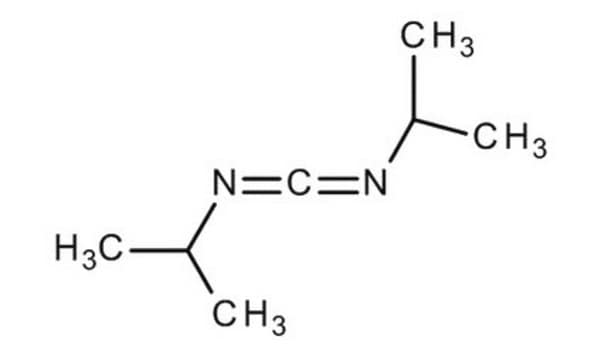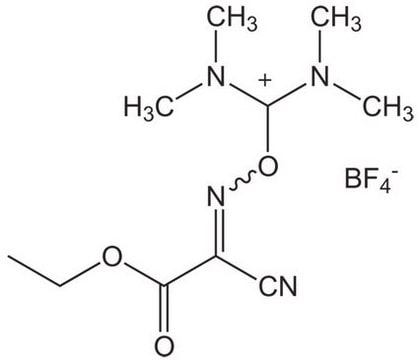Products may be shipped at a different temperature than the recommended long-term storage temperature. If the product quality is sensitive to short-term exposure to conditions other than the recommended long-term storage, it will be shipped on wet or dry-ice. If the product quality is NOT affected by short-term exposure to conditions other than the recommended long-term storage, it will be shipped at ambient temperature. As shipping routes are configured for minimum transit times, shipping at ambient temperature helps control shipping costs for our customers. For more information, please refer to the Storage and Transport Conditions document: https://www.sigmaaldrich.com/deepweb/assets/sigmaaldrich/marketing/global/documents/316/622/storage-transport-conditions-mk.pdf
8.51086
Oxyma Pure
≥99.0% (HPLC), for peptide synthesis, Novabiochem®
Synonym(s):
Oxyma Pure, Ethyl cyano(hydroxyimino)acetate
About This Item
Recommended Products
Product Name
Oxyma Pure, Novabiochem®
Quality Level
product line
Novabiochem®
Assay
≥99.0% (HPLC)
form
crystalline powder
reaction suitability
reaction type: Coupling Reactions
manufacturer/tradename
Novabiochem®
mp
130-132 °C
application(s)
peptide synthesis
storage temp.
2-8°C
InChI
1S/C5H6N2O3/c1-2-10-5(8)4(3-6)7-9/h9H,2H2,1H3/b7-4+
InChI key
LCFXLZAXGXOXAP-QPJJXVBHSA-N
General description
The generation of toxic hydrogen cyanide (HCN) from the reaction between Oxyma Pure and DIC has been observed.[3] Fortunately, this side reaction can be eliminated by substituting DIC for the more hindered t-butylethylcarbodiimide.[4]
Associated Protocols and Technical Articles
Guide to Selection of Coupling Reagents
Literature references:
[1] R. Subirós-Funosas, et al. (2009) Chem. Eur. J., 15, 9394
[2] J. Collins , et al. (2014) Org . Lett ., 16, 940.
[3] A. D. McFarland (2019) Org. Process Res. Dev., 23, 2099.
[4] S. R. Manne, et al (2022) Org. Process Res. Dev., 26, 2894.
Application
Features and Benefits
- Can be used in place of HOBt in carbodiimide-mediated coupling reactions without change of protocol
- It gives results comparable to HOAt in step-wise solid-phase synthesis
- Less epimerization than HOBt in fragment condensation reactions
Analysis Note
Appearance of substance (visual): crystalline powder
Assay (HPLC, area%): ≥ 99.0 % (a/a)
Identity (IR): passes test
Solubility (12,5 mmol in 25 ml DMF): clearly soluble
Legal Information
Storage Class Code
11 - Combustible Solids
WGK
WGK 3
Flash Point(F)
Not applicable
Flash Point(C)
Not applicable
Certificates of Analysis (COA)
Search for Certificates of Analysis (COA) by entering the products Lot/Batch Number. Lot and Batch Numbers can be found on a product’s label following the words ‘Lot’ or ‘Batch’.
Already Own This Product?
Find documentation for the products that you have recently purchased in the Document Library.
Customers Also Viewed
-
How is shipping temperature determined? And how is it related to the product storage temperature?
1 answer-
Helpful?
-
-
How can I determine the shelf life / expiration / retest date of this product?
1 answer-
If this product has an expiration or retest date, it will be shown on the Certificate of Analysis (COA, CofA). If there is no retest or expiration date listed on the product's COA, we do not have suitable stability data to determine a shelf life. For these products, the only date on the COA will be the release date; a retest, expiration, or use-by-date will not be displayed.
For all products, we recommend handling per defined conditions as printed in our product literature and website product descriptions. We recommend that products should be routinely inspected by customers to ensure they perform as expected.
For products without retest or expiration dates, our standard warranty of 1 year from the date of shipment is applicable.
For more information, please refer to the Product Dating Information document: https://www.sigmaaldrich.com/deepweb/assets/sigmaaldrich/marketing/global/documents/449/386/product-dating-information-mk.pdfHelpful?
-
Active Filters
Our team of scientists has experience in all areas of research including Life Science, Material Science, Chemical Synthesis, Chromatography, Analytical and many others.
Contact Technical Service












